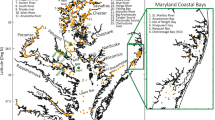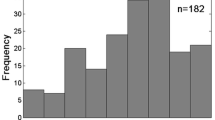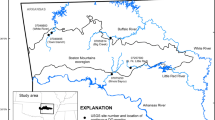Abstract
Low dissolved oxygen (DO) levels often occur during summer in tidal creeks along the southeastern coast of the USA. We analyzed rates of oxygen loss as water-column biochemical oxygen demand (BOD5) and sediment oxygen flux (SOF) at selected tidal creek sites monthly over a 1-year period. Ancillary physical, chemical and biological data were collected to identify factors related to oxygen loss. BOD5 rates ranged from 0.0 mg l−1 to 7.6 mg l−1 and were correlated positively with organic suspended solids, total suspended solids, chlorophyll a concentrations, temperature, and dissolved oxygen, and negatively with pH and nitrate + nitrite. SOF rates ranged from 0.0 to 9.3 g O2 m−2 d−1, and were positively correlated with temperature, chlorophyll a, and total suspended solids, but negatively with dissolved oxygen. Both forms of oxygen uptake were seasonally dependent, with BOD5 elevated in spring and summer and SOF elevated in summer and fall. Average oxygen loss to sediments was greater and more variable than oxygen loss in the water column. Oxygen deficits at three of five locations were significantly related to BOD5 and SOF, but not at two sites where ground water discharges were observed. Correlation and principal component analyses suggested that BOD5 and SOF responded to somewhat different suites of environmental variables. BOD5 was driven by a set of parameters linked to warm season storm water inputs that stimulated organic seston loads, especially chlorophyll a, while SOF behaved less strongly so. Runoff processes that increase loads of organic material and nutrients and ground water discharges low in dissolved oxygen contribute to occurrences of low dissolved oxygen in tidal creeks.






Similar content being viewed by others
References
Barranguet, C., M. R. Plante-Cuny & E. Alivon, 1996. Microphytobenthos production in the Gulf of Fos, French Mediterranean coast. Hydrobiologia 333: 181–193.
Bertuzzi, A., J. Faganeli, C. Welter & A. Brambati, 1997. Benthic fluxes of dissolved inorganic carbon, nutrients and oxygen in the Gulf of Trieste (Northern Adriatic). Water, Air and Soil Pollution 99: 305–314.
Boucher, G. & J. Clavier, 1990. Contribution of benthic biomass to overall metabolism in New Caledonia lagoon sediments. Marine Ecology Progress Series 64: 271–280.
Boynton, W. & W. Kemp, 1985. Nutrient regeneration and oxygen consumption by sediments along an estuarine salinity gradient. Marine Ecology Progress Series 23: 45–55.
Cahoon, L. B, 1988. Use of whirling cup rotors to stir benthic chambers. Hydrobiologia 160: 193–198.
Cahoon, L. B., 1996. An instrumented lander for measurement of benthic respiration and production. In Lang, M. A. & C. C. Baldwin (eds), Methods and Techniques of Underwater Research, Proceedings of the American Academy of Underwater Sciences, 1996 Scientific Diving Symposium, American Academy of Underwater Sciences, Nahant, Massachusetts, 45–52.
Cahoon, L. B. & J. E. Cooke, 1992. Benthic microalgal production in Onslow Bay, North Carolina. Marine Ecology Progress Series 84: 185–196.
Cahoon, L. B., G. R. Beretich Jr., C. J. Thomas & A. M. McDonald, 1993. Benthic microalgal production at Stellwagen Bank, Massachusetts Bay, USA. Marine Ecology (Progress Series) 102: 179–185.
Caldwell, J. M. & M. C. Doyle, 1995. Sediment oxygen demand in the Lower Willamette River, Oregon, 1994. United States Geological Survey Water-Resources Investigations Report 95–4196: 1–14.
Christenson, J. P., J. W. Murray, A. H. Devol & L. A. Codispoti, 1987. Denitrification in continental shelf sediments has major impact on the oceanic nitrogen budget. Global Biogeochemical Cycles 1: 91–116.
Davis, M. W. & C. D. McIntire, 1983. Effects of physical gradients on the production dynamics of sediment-associated algae. Marine Ecology Progress Series 13: 103–114.
Dollar, S., S. Smith, S. Vink, S. Obreski & J. Hollibaugh, 1991. Annual cycle of benthic nutrient fluxes in Tomales Bay, California, and contribution of the benthos to total ecosystem metabolism. Marine Ecology Progress Series 79: 115–125.
Eaton, A. D., L. S. Clesceri & A. E. Greenberg, 1995. Standard Methods for the Examination of Water and Wastewater. United Book Press Inc., Baltimore, Maryland, 5.3–5.6.
Folk, R. L., 1980. Petrology of Sedimentary Rocks. Hemphill Publishing, Austin, Texas, 182 pp.
Hargrave, B. T., N. J. Prouse, G. A. Phillips & P. A. Neame, 1983. Primary production and respiration in pelagic and benthic communities at two intertidal sites in the upper Bay of Fundy. Canadian Journal of Fisheries and Aquatic Sciences 40(Suppl. 1): 229–243.
Hartwig, E. O., 1978. Factors affecting respiration and photosynthesis by the benthic community of a subtidal siliceous sediment. Marine Biology 46: 283–293.
Herndl, G. J., P. Peduzzi & N. Fanuko, 1989. Benthic community metabolism and microbial dynamics in the Gulf of Trieste (Northern Adriatic Sea). Marine Ecology Progress Series 53: 169–178.
Hofman, P. A. G., S. A. de Jong, E. J. Wagenvoort & A. J. J. Sandee, 1991. Apparent sediment diffusion coefficients for oxygen and oxygen consumption rates measured with microelectrodes and bell jars: Applications to oxygen budgets in estuarine intertidal sediments (Ossterschelde, SW Netherlands). Marine Ecology Progress Series 69: 261–272.
Hopkinson, C. S., 1985. Shallow-water benthic and pelagic metabolism: evidence of heterotrophy in the nearshore Georgia Bight. Marine Biology 87: 19–32.
Hopkinson, C. S. Jr., R. D. Fallon, B.-O. Jansson & J. P. Schubauer, 1991. Community metabolism and nutrient cycling at Gray’s Reef, a hard bottom habitat in the Georgia Bight. Marine Ecology Progress Series 73: 105–120.
Huettel, M. & G. Gust, 1992. Solute-release mechanisms from confined sediment cores in stirred benthic chambers and flume flows. Marine Ecology Progress Series 82: 187–197.
Johnson, V. L., 2005. Primary productivity by phytoplankton: Temporal, spatial and tidal variability in two North Carolina tidal creeks. M.S. Thesis, The University of North Carolina Wilmington, 73 pp.
Kemp, W. M., P. A. Sampou, J. Garber, J. Tuttle & W. R. Boynton, 1992. Seasonal depletion of oxygen from bottom waters of Chesapeake Bay—roles of benthic and planktonic respiration and physical exchange processes. Marine Ecology Progress Series 85: 137–152.
Laws, E. A., 1993. Aquatic Pollution. John Wiley and Sons Inc., New York, 611 pp.
Lerberg, S. B., A. F. Holland & D. M. Sanger, 2000. Responses of tidal creek macrobenthic communities to the effects of watershed development. Estuaries 23: 838–853.
López, P., M. Vidal, X. Lluch & J. A. Morgui, 1995. Sediment metabolism in a transitional continental/marine area: The Albufera of Majorca (Balearic Islands, Spain). Marine and Freshwater Research 46: 45–53.
Mallin, M. A. & C. A. Corbett, 2006. Multiple hurricanes and different coastal systems: How hurricane attributes determine the extent of environmental impacts. Estuaries and Coasts 29: 1046–1061.
Mallin, M. A., L. B. Cahoon, J. J. Manock, J. F. Merritt, M. H. Posey, R. K. Sizemore, T. D. Alphin, K. E. Williams & E. D. Hubertz, 1996. Water quality in New Hanover County Tidal Creeks, 1995–1996. Center for Marine Science Research, University of North Carolina at Wilmington, Wilmington, N.C., 1–67.
Mallin, M. A., L. B. Cahoon, J. J. Manock, J. F. Meritt, M. H. Posey, T.D. Alphin, D.C. Parsons & T. L. Wheeler, 1998. Environmental quality of Wilmington and New Hanover County watersheds, 1997–1998. Center for Marine Science, University of North Carolina-Wilmington, CMS Report 98–03: 1–76.
Mallin, M. A., L. B. Cahoon, R. P. Lowe, J. F. Merritt, R. K. Sizemore & K. E. Williams, 2000. Restoration of shellfishing waters in a tidal creek following limited dredging. Journal of Coastal Research 16: 40–47.
Mallin, M. A., D. C. Parsons, V. L. Johnson, M. R. McIver & H. A. CoVan, 2004. Nutrient limitation and algal blooms in urbanizing tidal creeks. Journal of Experimental Marine Biology and Ecology 298: 211–231.
Mallin, M. A., V. L. Johnson, S.H. Ensign & T.A. Macpherson, 2006. Factors contributing to hypoxia in rivers, lakes and streams. Limnology and Oceanography 51: 690–701.
Medine, A., D. B. Porcella & D. V. Adams, 1980. Heavy-metal and nutrient effects on sediment oxygen demand in three-phase aquatic microcosms. Microcosms in Ecological Research. Technical Information Center, U.S. Department of Energy, Washington, D.C. (USA) 52: 279–303.
Middelburg, J. J., C. M. Duarte & J.-P. Gattuso, 2005. Respiration in coastal benthic communities. In Del Giorgio, P. A. & P. J. LeB. Williams (eds), Respiration in Aquatic Ecosystems, Oxford University Press, New York, 206–224.
National Research Council, 2000. Clean Coastal Waters-Understanding and Reducing the Effects of Pollution. National Academy Press, 405 pp.
Reay, W. G., D. L. Gallagher & G. M. Simmons Jr, 1995. Sediment–water column oxygen and nutrient fluxes in nearshore environments of the lower Delmarva peninsula, USA. Marine Ecology Progress Series 118: 251–227.
Roberts, T. L. 2002. Chemical constituents in the Peedee and Castle Hayne aquifers: Porters Neck Area, New Hanover County, North Carolina. M.S. Thesis. University of North Carolina at Wilmington, 63 pp.
Rounds, S. A. & M. C. Doyle, 1997. Sediment oxygen demand in the Tualatin River Basin, Oregon, 1992–96. U.S. Geological Survey Water-Resources Investigations Report 97-4103: 1–19.
Sand-Jensen, K., L. M. Jensen, S. Marcher & M. Hansen, 1990. Pelagic metabolism in eutrophic coastal waters during a late summer period. Marine Ecology Progress Series 65: 63–72.
Simmons, G. M. Jr, 1992. Importance of submarine groundwater discharge (SGWD) and seawater cycling to material flux across sediment/water interfaces in marine environments. Marine Ecology Progress Series 84: 173–184.
Strickland, J. D. H. & T. R. Parsons, 1972. A Practical Handbook of Seawater Analysis. Fisheries Research Board of Canada, Ottawa, 310 pp.
Van Es, F., 1982. Community metabolism of intertidal flats in the Ems-Dollard Estuary. Marine Biology 66: 95–108.
Acknowledgements
Funding for this project came from the Glaxo Wellcome Fellowship in Oceans and Human Health, a Bryden grant from the North Carolina Academy of Science, the UNCW Center for Marine Science, the Department of Biological Sciences, the Graduate School at the University of North Carolina Wilmington and the New Hanover County Tidal Creeks Program. We thank Dr. Lynn Leonard for laboratory guidance, Dr. Dargan Frierson for assistance with statistical analysis, Dr. and Mrs. Paul Hosier and Mr. and Mrs. Davie for allowing access to sampling sites through their property, and Alex Croft, Virginia Johnson, Scott Ensign, Dawn Carroll York, Gina Root, Doug Parsons, Heather CoVan Wells and Bryan Bishop for assistance in the field and laboratory.
Author information
Authors and Affiliations
Corresponding author
Additional information
Handling editor: K. Martens
Rights and permissions
About this article
Cite this article
MacPherson, T.A., Cahoon, L.B. & Mallin, M.A. Water column oxygen demand and sediment oxygen flux: patterns of oxygen depletion in tidal creeks. Hydrobiologia 586, 235–248 (2007). https://doi.org/10.1007/s10750-007-0643-4
Received:
Revised:
Accepted:
Published:
Issue Date:
DOI: https://doi.org/10.1007/s10750-007-0643-4




